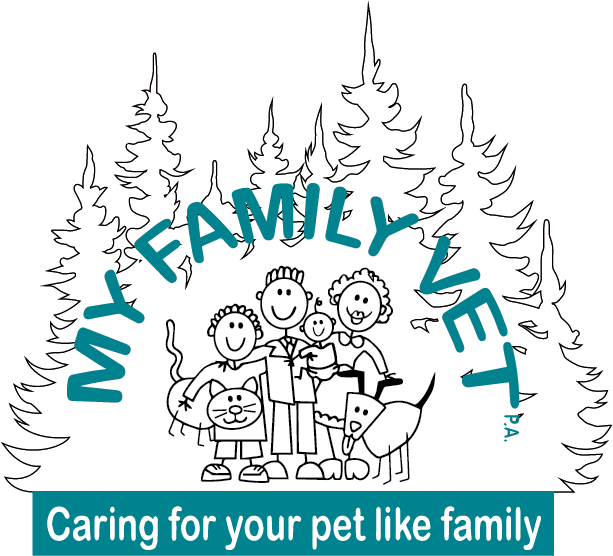Body Condition Scoring in Dogs
What is a Body Condition Score?
The Body Condition Score (BCS) is a way to check if a pet is too skinny, too heavy, or just right. It allows a pet owner to determine how much fat their pet has compared to the muscles and bones that make up their body structure (percentage of body fat). To figure it out, the pet's body shape is assessed visually and by palpating (feeling) fat over specific anatomical sites.
There are two recognized BCS scales for dogs: a 5-point scale (scores range from 1 to 5) and a 9-point scale (scores range from 1 to 9). The 9-point scale allows for more subtle distinctions in condition than the 5-point scale.
It is important to indicate which scale you are using, as scores will differ depending on the scale. For example, a dog with a BCS of 5 would be obese on the 5-point scale (5/5), but an ideal weight on the 9-point scale (5/9). By providing your score as a fraction, it helps to better explain the score.
Here is a summary of both scales:

How do you assign a BCS?
To assign a BCS score, you must look at and feel your pet.
Look
Observe your pet for signs of healthy weight.
- Look at your dog from above. Do they have a waistline that curves in, behind the rib cage, like an hourglass?
- Sit on the floor and look at your dog from the side. Does their abdomen slant upwards between the ribcage and the hind legs (a tummy tuck)? Or do they have a saggy belly?
Feel
Feel your dog’s ribs. Place your thumbs on the backbone and spread your fingers across their rib cage. If your dog is a healthy weight, you should feel a thin layer of fat with the ribs right underneath. Compare it to the feeling of the knuckles on your hand:
- Underweight: The ribs feel like your knuckles when you close your fist.
- Overweight: The ribs feel like your knuckles on the palm side of your hand.
- Ideal weight: The ribs feel like your knuckles when your hand rests on a flat surface.
In a dog with a BCS of 3/5 or 4–5/9, the ribs will be easy to palpate without applying any pressure with your fingers. An emaciated dog with a BCS of 1/5 or 1/9 will have ribs that stick out, and no fat layer; they are easy to see and feel. Obese dogs with a BCS of 5/5 or 9/9 have ribs covered by a thick layer of fat, making them very difficult to see or feel.
You can also run your hands over your dog’s rump to feel the pelvic bones. And pet them from neck to tail to feel the backbone. Both areas should be covered with minimal fat, allowing you to feel bone without pressing too hard.
Note: Feeling a dog’s ribs disturbs the dog less than feeling their backbone or pelvis. Arthritic dogs may experience pain if you press on their back or hips.
Assign a Numerical Score
Based on what you have seen and felt, you can now assign a score.
1/5 or 1/9: Ribs, backbone, and pelvic bones stick out. Muscle loss is evident. Dramatic waistline and severe tummy tuck are visible.
1.5/5 or 2/9: Ribs, backbone, and pelvic bones visible, but only minor loss of muscle mass is visible. Severe waistline and tummy tuck are visible.
2/5 or 3/9: Ribs, pelvis, and backbone are easily felt and somewhat visible. Severe waistline and tummy tuck are visible.
2.5/5 or 4/9: Ribs, pelvis, and backbone are easily felt but not as visible. Obvious waistline and tummy tuck are visible.
3/5 or 5/9: Ribs, pelvis, and backbone can be felt, with a thin layer of fat covering. Waistline and tummy tuck obvious, but not severe, with more gradual curves.
3.5/5 or 6/9: Slight fat layer over ribs, backbone, and pelvis making them more difficult to feel. Tummy tuck present but minimal. Waistline visible, but not prominent.
4/5 or 7/9: Ribs covered with heavy fat layer that requires finger pressure to feel. It is difficult to feel backbone or pelvis. Waistline not apparent. Tummy tuck still slightly visible.
4.5/5 or 8/9: Ribs, pelvis, and backbone covered with thick fat layer and are palpable only with extreme pressure. No tummy tuck or waistline.
5/5 or 9/9: Ribs and backbone not palpable under thick fat layer. The belly projects downward (opposite of tummy tuck) and outward (protruding waistline). Fat deposits on legs, face, and over tail head covering pelvis.
Note: A BCS of 4/5 or 7/9 in dogs correlates to 30% body fat, which is considered overweight in humans.
How does BCS help determine my dog’s ideal body weight?
Determining a dog’s ideal body weight takes into consideration both BCS and actual weight. If your dog is on a weight management program, it is important to record both numbers simultaneously. Get into the habit of weighing your dog each time you assess their BCS and keep an ongoing record.
Why do I need to be concerned about my dog’s BCS?
Obesity is the most common health condition affecting dogs and cats in the United States. Overweight pets have shorter lifespans. Obesity can increase the risk of heart disease, diabetes, arthritis, high blood pressure, and anesthetic complications. By ensuring your pet has a healthy BCS, you will make their life happier, healthier and longer.
© Copyright 2025 LifeLearn Inc. Used and/or modified with permission under license. This content written by LifeLearn Animal Health (LifeLearn Inc.) is licensed to this practice for the personal use of our clients. Any copying, printing or further distribution is prohibited without the express written consent of LifeLearn. This content does not contain all available information for any referenced medications and has not been reviewed by the FDA Center for Veterinary Medicine, or Health Canada Veterinary Drugs Directorate. This content may help answer commonly asked questions, but is not a substitute for medical advice, or a proper consultation and/or clinical examination of your pet by a veterinarian. Please contact your veterinarian if you have any questions or concerns about your pet’s health. Last updated on Jul 7, 2025.


